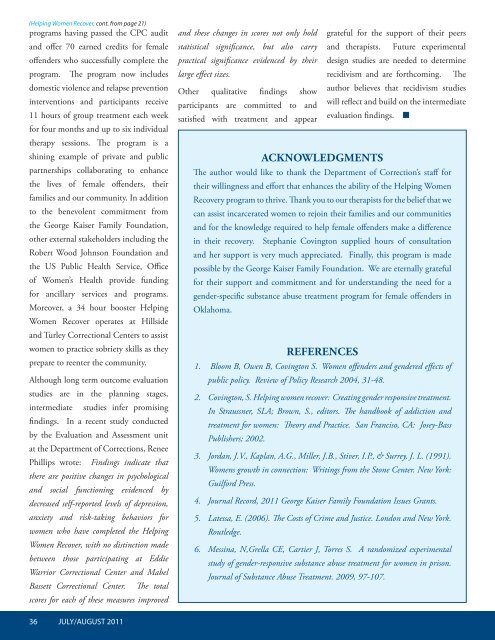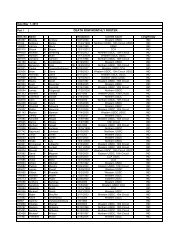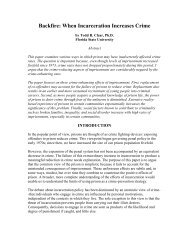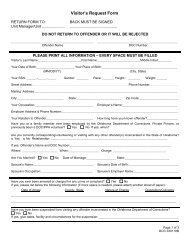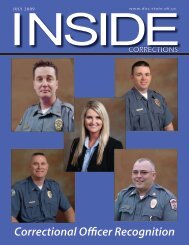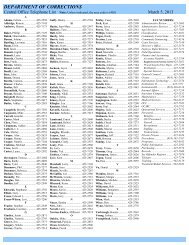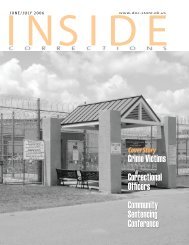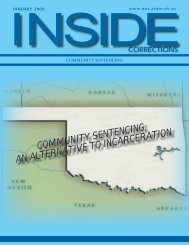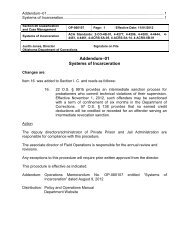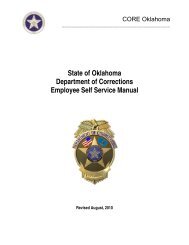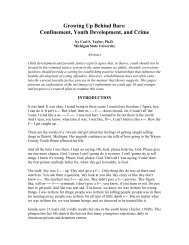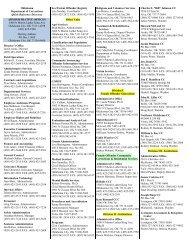Programs, Mental Health, Medical & Education - Oklahoma ...
Programs, Mental Health, Medical & Education - Oklahoma ...
Programs, Mental Health, Medical & Education - Oklahoma ...
You also want an ePaper? Increase the reach of your titles
YUMPU automatically turns print PDFs into web optimized ePapers that Google loves.
(Helping Women Recover, cont. from page 21)<br />
programs having passed the CPC audit<br />
and offer 70 earned credits for female<br />
offenders who successfully complete the<br />
program. The program now includes<br />
domestic violence and relapse prevention<br />
interventions and participants receive<br />
11 hours of group treatment each week<br />
for four months and up to six individual<br />
therapy sessions. The program is a<br />
shining example of private and public<br />
partnerships collaborating to enhance<br />
the lives of female offenders, their<br />
families and our community. In addition<br />
to the benevolent commitment from<br />
the George Kaiser Family Foundation,<br />
other external stakeholders including the<br />
Robert Wood Johnson Foundation and<br />
the US Public <strong>Health</strong> Service, Office<br />
of Women’s <strong>Health</strong> provide funding<br />
for ancillary services and programs.<br />
Moreover, a 34 hour booster Helping<br />
Women Recover operates at Hillside<br />
and Turley Correctional Centers to assist<br />
women to practice sobriety skills as they<br />
prepare to reenter the community.<br />
Although long term outcome evaluation<br />
studies are in the planning stages,<br />
intermediate studies infer promising<br />
findings. In a recent study conducted<br />
by the Evaluation and Assessment unit<br />
at the Department of Corrections, Renee<br />
Phillips wrote: Findings indicate that<br />
there are positive changes in psychological<br />
and social functioning evidenced by<br />
decreased self-reported levels of depression,<br />
anxiety and risk-taking behaviors for<br />
women who have completed the Helping<br />
Women Recover, with no distinction made<br />
between those participating at Eddie<br />
Warrior Correctional Center and Mabel<br />
Bassett Correctional Center. The total<br />
scores for each of these measures improved<br />
36 JULY/AUGUST 2011<br />
and these changes in scores not only hold<br />
statistical significance, but also carry<br />
practical significance evidenced by their<br />
large effect sizes.<br />
Other qualitative findings show<br />
participants are committed to and<br />
satisfied with treatment and appear<br />
grateful for the support of their peers<br />
and therapists. Future experimental<br />
design studies are needed to determine<br />
recidivism and are forthcoming. The<br />
author believes that recidivism studies<br />
will reflect and build on the intermediate<br />
evaluation findings.<br />
ACKNOWLEDGMENTS<br />
The author would like to thank the Department of Correction’s staff for<br />
their willingness and effort that enhances the ability of the Helping Women<br />
Recovery program to thrive. Thank you to our therapists for the belief that we<br />
can assist incarcerated women to rejoin their families and our communities<br />
and for the knowledge required to help female offenders make a difference<br />
in their recovery. Stephanie Covington supplied hours of consultation<br />
and her support is very much appreciated. Finally, this program is made<br />
possible by the George Kaiser Family Foundation. We are eternally grateful<br />
for their support and commitment and for understanding the need for a<br />
gender-specific substance abuse treatment program for female offenders in<br />
<strong>Oklahoma</strong>.<br />
REFERENCES<br />
1. Bloom B, Owen B, Covington S. Women offenders and gendered effects of<br />
public policy. Review of Policy Research 2004, 31-48.<br />
2. Covington, S. Helping women recover: Creating gender responsive treatment.<br />
In Straussner, SLA; Brown, S., editors. The handbook of addiction and<br />
treatment for women: Theory and Practice. San Franciso, CA: Josey-Bass<br />
Publishers; 2002.<br />
3. Jordan, J.V., Kaplan, A.G., Miller, J.B., Stiver, I.P., & Surrey, J. L. (1991).<br />
Womens growth in connection: Writings from the Stone Center. New York:<br />
Guilford Press.<br />
4. Journal Record, 2011 George Kaiser Family Foundation Issues Grants.<br />
5. Latessa, E. (2006). The Costs of Crime and Justice. London and New York.<br />
Routledge.<br />
6. Messina, N,Grella CE, Cartier J, Torres S. A randomized experimental<br />
study of gender-responsive substance abuse treatment for women in prison.<br />
Journal of Substance Abuse Treatment. 2009, 97-107.


